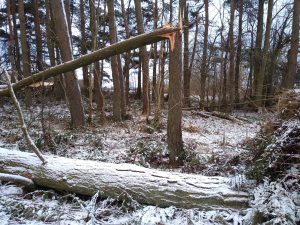As the extent of the damage from last year’s winter storms on trees across Great Britain is revealed for the first time, woodland owners are encouraged to plant and manage more diverse and resilient forests of varying ages and species in the face of climate change.
Updated Forest Research assessments released today show almost 12,750 hectares of tree loss was caused by storms last winter in Great Britain, with approximately 3,350 hectares of damage recorded in England. The majority of the damage was as a result of Storm Arwen, a powerful extra-tropical cyclone which brought significant windblow and woodland damage to the United Kingdom, Ireland and France on 26-27 November 2021. The damage overall is relatively modest equating to around 0.2% of England’s tree cover and will not impact on tree planting targets. Over 90 percent of trees which fall as a result of storm damage will be replanted, meaning only a small percent of forest is actually lost in the long term where it is not possible to restock.

In light of the findings, Sir William Worsley, Chair of the Forestry Commission, has called for landowners and forest managers to consider planting more diverse and resilient tree species and better designed woodlands in the face of a changing climate. Their long-term prosperity will depend on their resilience to threats caused by climate change, such as stronger gales, drought, emerging pests and diseases, evolving weather patterns and more frequent, severe weather events.
Chair of the Forestry Commission, Sir William Worsley said:
The figures released today highlight the challenges we are facing with a changing climate and more frequent and extreme storm events. The woodlands of the future need to be planted and managed differently if they are to not only survive but thrive in the future.
Now and in the long-term, we need a wider range of tree species and age profiles across the country. This targeted approach will ensure the long-term resilience of our precious woodlands.
At a national scale, the level of loss is comparatively modest, but the loss of trees can also have a devastating impact on individual woodland owners, and we continue to support the forestry sector and partners with their recovery from winter storms.
The tree loss figures are made up of assessments of the damage using a combination of satellite imaging techniques and machine learning. An additional citizen science project was then carried out, where foresters, land managers and landowners could report the damage on the ground. This project, combined with improvements to the machine learning algorithms used within the satellite data and mapping work, allowed smaller areas of damage (less than 0.5ha) to be captured. This significantly improved the accuracy of the damage assessment.
The Forestry Commission advice is for a greater variety of tree species to be planted to build our forests of the future. In addition, to counter future storm risk, forests and woodlands should have a broad range of trees at different ages, from seedlings to those more fully grown to foster a variety of sizes. Larger, more mature trees are more susceptible to severe winds than younger trees; so promoting the growth of trees of varying ages helps to strengthen their collective resilience.
In addition, woodland managers, landowners and the forestry sector need to consider the most suitable trees for conditions now and in the future, as well as how they can alter thinning regimes to ensure the optimal structure of their woodlands. This will help to avoid situations where storms topple large areas of woodland in coming years. These measures are key to secure precious wildlife habitats and a vital supply of sustainable, domestic timber for future generations.
The Forestry Commission’s role is to promote and support best practice in woodland management. It is committed to increasing the amount of woodlands under active management and provides grants to help land managers to better plan and nurture their woodlands. It also supports the delivery of the Government’s tree planting targets.
It is not anticipated that the storms will have any significant impact on tree planting targets, as new trees will grow from seed naturally and many woodland owners will replant their woodlands, particularly where timber production is an important part of their business. The damage from Storm Arwen in England occurred predominately in commercially important woodlands in the North East of England and in and around Kielder Forest. £700,000 of additional funding has also been allocated to Forestry England in the North of England to help support the repair of damaged recreation infrastructure which is vital to supporting local tourism and the leisure economy in the area.
Find out more about remote sensing and forestry.
Planting woodland adjacent to established woodland or in large clumps is more likely to boost bird populations than random planting, modelling suggests.

Forest Research has announced that Dr Bianca Ambrose-Oji, currently Head of its Society and Environment Research Group, will succeed Professor Chris Quine FRSE as Chief Scientist from June 2025.
England’s non-woodland trees have been mapped for the first time, revealing these trees make up nearly one third of our nation’s tree cover.
Planting woodland adjacent to established woodland or in large clumps is more likely to boost bird populations than random planting, modelling suggests.

Forest Research has announced that Dr Bianca Ambrose-Oji, currently Head of its Society and Environment Research Group, will succeed Professor Chris Quine FRSE as Chief Scientist from June 2025.
England’s non-woodland trees have been mapped for the first time, revealing these trees make up nearly one third of our nation’s tree cover.